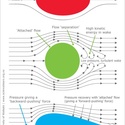English astronomer John Robinson invented the anemometer in 1846. Anemometers measure wind speed and have become one of the essential tools for weather forecasting.
‘Anemos’ is the Greek word for wind. Wind is the movement of air and will make the cups of the anemometer spin around. The speed of the spin depends upon the strength of the wind. Wind speed can be measured in knots, kilometres or metres per second or on the Beaufort wind scale.
In this activity, students will construct a simple anemometer. This activity supports the development of the science capabilities, especially ‘Gather and interpret data’, ‘Use evidence’ and ‘Critique evidence’.
By the end of this activity, students should be able to:
- build a simple anemometer
- collect data using their anemometer
- interpret and make meaning of their data
- discuss the reliability of their data.
Download the Word file (see link below) for:
- background information for teachers
- equipment list
- student instructions
- extension ideas/prompting questions for teachers.
Activities are designed to be adaptable to meet students’ requirements, age level and ability.
Nature of science
In this activity, students will build on their understandings about how scientists use tools to measure and collect data about the environment.
Activity ideas
This activity is part of a set of five activities designed to support students collecting data about the weather. The other activities are:
Related content
Explore the science concepts that underpin the nature and properties of air with The air around us interactive.
Useful link
Download this Measuring the wind poster from MetService.





